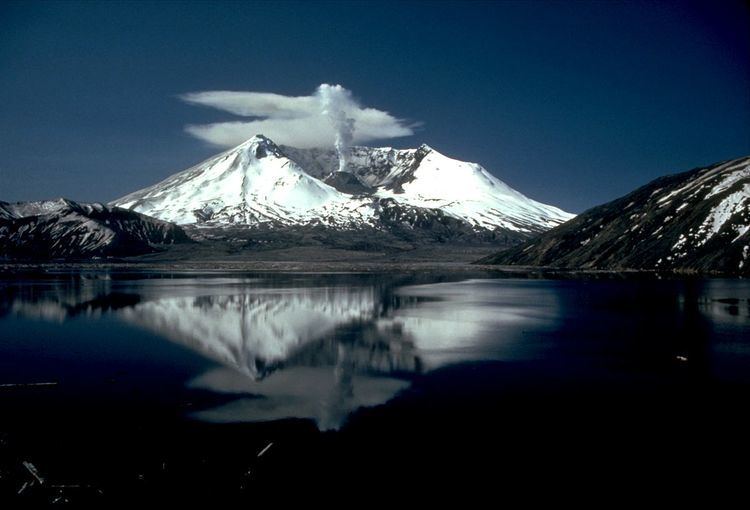Governing body U.S. Forest Service Phone +1 360-449-7800 | Area 445.2 km² Established August 26, 1982 | |
 | ||
Created August 26, 1982 (1982-08-26) Hours Open today · 6AM–10PMMonday6AM–10PMTuesday6AM–10PMWednesday6AM–10PMThursday6AM–10PMFriday6AM–10PMSaturday6AM–10PMSunday6AM–10PM Management United States Forest Service | ||
Mount st helens national volcanic monument coldwater lake loop
Mount St. Helens National Volcanic Monument is a U.S. National Monument that includes the area around Mount St. Helens in Washington. It was established on August 27, 1982 by U.S. President Ronald Reagan following the 1980 eruption. The 110,000 acre (445 km2) National Volcanic Monument was set-aside for research, recreation, and education. Inside the Monument, the environment is left to respond naturally to the disturbance.
Contents
- Mount st helens national volcanic monument coldwater lake loop
- Mount st helens national volcanic monument 1986
- Mount St Helens Visitor Center at Silver LakeEdit
- Johnston Ridge ObservatoryEdit
- Science and Learning Center at ColdwaterEdit
- South and East sides of Mount St HelensEdit
- Bear MeadowsEdit
- Windy RidgeEdit
- References
Mount St. Helens National Volcanic Monument was the United States' first such monument managed by the U.S. Forest Service. At dedication ceremonies on May 18, 1983, Max Peterson, head of the USFS, said, "we can take pride in having preserved the unique episode of natural history for future generations." Since then, many trails, viewpoints, information stations, campgrounds, and picnic areas have been established to accommodate the increasing number of visitors each year.
Beginning in the summer of 1983, visitors have been able to drive to Windy Ridge, only 4 miles (6.4 km) northeast of the crater.
Mountain climbing to the summit of the volcano has been allowed since 1986.
Mount st helens national volcanic monument 1986
Mount St. Helens Visitor Center at Silver LakeEdit
A visitor center was completed in December 1986 at Silver Lake, about 30 miles (48 km) west of Mount St. Helens and five miles (8 km) east of Interstate 5. By the end of 1989, the Center had hosted more than 1.5 million visitors.
The Mount St. Helens Visitor Center at Silver Lake opened in 1987 and has been operated by the Washington State Park System since October 2000. Exhibits include the area's culture and history, and the natural history and geology of the volcano and the eruption, including the recovery of the area's vegetation and animal life. The Center includes a theater, a gift shop and outdoor trails. A small admission fee is charged.
The Center was formerly operated by the U.S. Forest Service.
Johnston Ridge ObservatoryEdit
The Johnston Ridge Observatory is located 52 miles (84 km) east of Castle Rock, Washington, at the end of Washington State Route 504. Exhibits focus on the geologic history of the volcano, eyewitness accounts of the explosion, and the science of monitoring volcanic activity. Two movies and ranger-led programs are available every hour. A half-mile trail provides views of the lava dome, crater, pumice plain, and landslide deposit.
The observatory is located near the site of volcanologist David A. Johnston's camp on the morning of May 18, 1980, and opened in 1997.
Science and Learning Center at ColdwaterEdit
Opening in 1993 was an interpretation complex in the Coldwater Lake area. The visitor center closed temporarily in November 2007.
Since May 2013, the center has been operated as an educational facility and conference center in cooperation with the Mount St. Helens Institute. It is open to the public on weekends from 10am to 6pm. Many of the exhibits have been removed, but the gift shop, theatre, and some signage still exist.
The Winds of Change Trail #232, a short, barrier-free interpretive trail, departs from the Science and Learning Center.
South and East sides of Mount St. HelensEdit
The southern and eastern sides of Mount St. Helens are accessible only by U.S. Forest Service roads. The main roads are:
Bear MeadowsEdit
Bear Meadows is an alpine meadow and viewpoint northeast of Mt. St. Helens. It is located on U.S. Forest Service Road 99. Gary Rosenquist camped here with friends on May 17–18, 1980. He started taking his famous eruption photographs from this location. The sequence of eruption photos show give a time lapse view of the developing eruption. As the lateral blast developed, he and his friends abandoned their campsite fearing for their lives. He continued taking photos as they escaped in a car. The eruption's lateral blast narrowly missed the site as it was deflected by a ridge just west of the meadow. In an interview with KIRO-TV in 1990, a friend called that ridge "the line of death."
Windy RidgeEdit
Windy Ridge is the closest view point accessible to the general public. Beginning in the summer of 1983, visitors have been able to drive to Windy Ridge, on U.S. Forest Service Road 99, only 4 miles (6.4 km) northeast of the crater. From this vantage point overlooking Spirit Lake, people see firsthand not only the evidence of a volcano's destruction, but also the remarkable, gradual (but faster than originally predicted) recovery of the land as revegetation proceeds and wildlife returns.
